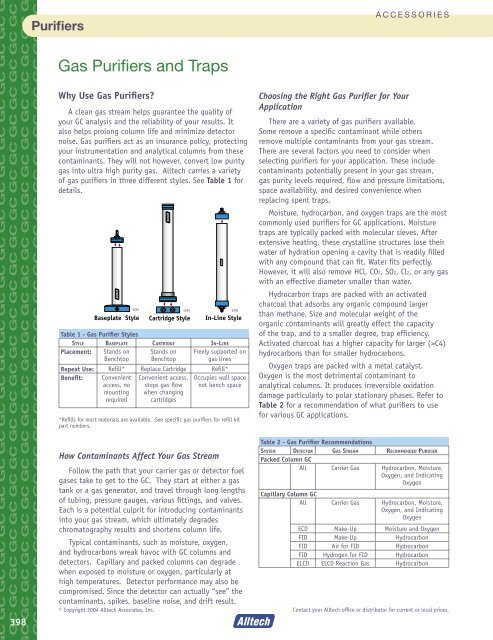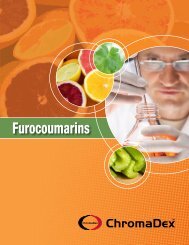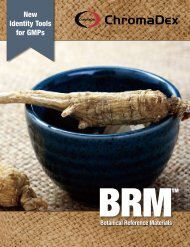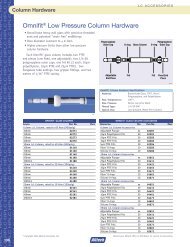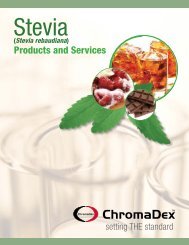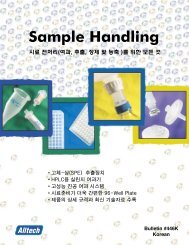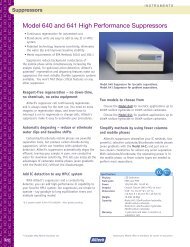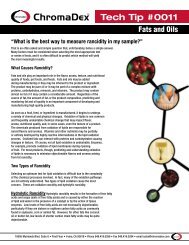GC Accessories
GC Accessories
GC Accessories
You also want an ePaper? Increase the reach of your titles
YUMPU automatically turns print PDFs into web optimized ePapers that Google loves.
Purifiers<br />
A C C E S S O R I E S<br />
Gas Purifiers and Traps<br />
Why Use Gas Purifiers?<br />
A clean gas stream helps guarantee the quality of<br />
your <strong>GC</strong> analysis and the reliability of your results. It<br />
also helps prolong column life and minimize detector<br />
noise. Gas purifiers act as an insurance policy, protecting<br />
your instrumentation and analytical columns from these<br />
contaminants. They will not however, convert low purity<br />
gas into ultra high purity gas. Alltech carries a variety<br />
of gas purifiers in three different styles. See Table 1 for<br />
details.<br />
5333 5334 5335<br />
Baseplate Style Cartridge Style In-Line Style<br />
Table 1 - Gas Purifier Styles<br />
STYLE BASEPLATE CARTRIDGE IN-LINE<br />
Placement:<br />
Stands on<br />
Benchtop<br />
Stands on<br />
Benchtop<br />
Freely supported on<br />
gas lines<br />
Repeat Use: Refill* Replace Cartridge Refill*<br />
Benefit: Convenient<br />
access, no<br />
mounting<br />
required<br />
Convenient access,<br />
stops gas flow<br />
when changing<br />
cartridges<br />
Occupies wall space<br />
not bench space<br />
*Refills for most materials are available. See specific gas purifiers for refill kit<br />
part numbers.<br />
Choosing the Right Gas Purifier for Your<br />
Application<br />
There are a variety of gas purifiers available.<br />
Some remove a specific contaminant while others<br />
remove multiple contaminants from your gas stream.<br />
There are several factors you need to consider when<br />
selecting purifiers for your application. These include<br />
contaminants potentially present in your gas stream,<br />
gas purity levels required, flow and pressure limitations,<br />
space availability, and desired convenience when<br />
replacing spent traps.<br />
Moisture, hydrocarbon, and oxygen traps are the most<br />
commonly used purifiers for <strong>GC</strong> applications. Moisture<br />
traps are typically packed with molecular sieves. After<br />
extensive heating, these crystalline structures lose their<br />
water of hydration opening a cavity that is readily filled<br />
with any compound that can fit. Water fits perfectly.<br />
However, it will also remove HCl, CO2, SO2, Cl2, or any gas<br />
with an effective diameter smaller than water.<br />
Hydrocarbon traps are packed with an activated<br />
charcoal that adsorbs any organic compound larger<br />
than methane. Size and molecular weight of the<br />
organic contaminants will greatly effect the capacity<br />
of the trap, and to a smaller degree, trap efficiency.<br />
Activated charcoal has a higher capacity for larger (>C4)<br />
hydrocarbons than for smaller hydrocarbons.<br />
Oxygen traps are packed with a metal catalyst.<br />
Oxygen is the most detrimental contaminant to<br />
analytical columns. It produces irreversible oxidation<br />
damage particularly to polar stationary phases. Refer to<br />
Table 2 for a recommendation of what purifiers to use<br />
for various <strong>GC</strong> applications.<br />
398<br />
How Contaminants Affect Your Gas Stream<br />
Follow the path that your carrier gas or detector fuel<br />
gases take to get to the <strong>GC</strong>. They start at either a gas<br />
tank or a gas generator, and travel through long lengths<br />
of tubing, pressure gauges, various fittings, and valves.<br />
Each is a potential culprit for introducing contaminants<br />
into your gas stream, which ultimately degrades<br />
chromatography results and shortens column life.<br />
Typical contaminants, such as moisture, oxygen,<br />
and hydrocarbons wreak havoc with <strong>GC</strong> columns and<br />
detectors. Capillary and packed columns can degrade<br />
when exposed to moisture or oxygen, particularly at<br />
high temperatures. Detector performance may also be<br />
compromised. Since the detector can actually “see” the<br />
contaminants, spikes, baseline noise, and drift result.<br />
© Copyright 2004 Alltech Associates, Inc.<br />
Table 2 - Gas Purifier Recommendations<br />
SYSTEM DETECTOR GAS STREAM RECOMMENDED PURIFIER<br />
Packed Column <strong>GC</strong><br />
All Carrier Gas Hydrocarbon, Moisture,<br />
Oxygen, and Indicating<br />
Oxygen<br />
Capillary Column <strong>GC</strong><br />
All Carrier Gas Hydrocarbon, Moisture,<br />
Oxygen, and Indicating<br />
Oxygen<br />
ECD Make-Up Moisture and Oxygen<br />
FID Make-Up Hydrocarbon<br />
FID Air for FID Hydrocarbon<br />
FID Hydrogen for FID Hydrocarbon<br />
ELCD ELCD Reaction Gas Hydrocarbon<br />
Contact your Alltech office or distributor for current or local prices.


